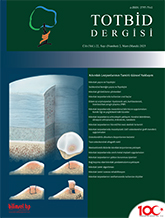
Diagnosis and treatment options in cartilage lesions do not have definite limits due to the insufficiency of blood supply and healing of the cartilage tissue. Although the patient`s age, activity level, expectation, alignment of the extremity, stability, localization, and stage of the cartilage lesion include some overlapping algorithms for both conservative and surgical methods, more patient-specific treatment methods are applied. Stem cell applications are also included among conservative and surgical treatments, and early information about the details and results of the method has begun to be obtained. The ability of adipose or bone marrow-derived stem cells to transform into cartilage tissue requires investigation of correct preparation and application techniques. After the obtained cells are separated from other cells by various methods, they are applied to the joint by injection, or the cartilage lesion can be repaired by implanting them on cartilage scaffolds. The possibility that this treatment can replace two-stage autologous chondrocyte implantation increases the interest in stem cells. Although the studies are promising, evaluation of clinical scores and patient satisfaction, as well as radiological and histological transformation into cartilage and healing will be possible with the results of more studies and long-term follow-up.